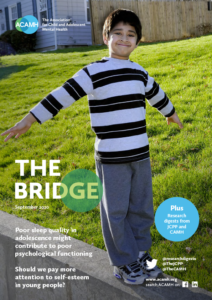Welcome to the September 2020 issue of The Bridge, click on the front cover to download the issue as a pdf.
Welcome to the September issue of The Bridge. The month of September is a challenging time for young people, as they start a new school year. September 2020 will be particularly difficult for many, as they must also deal with the stresses of the coronavirus pandemic and social distancing, as well as the effects of increasing financial pressures on families. Yet returning to school will provide most young people with important opportunities for development – including educational, social, and emotional development – and promote the health and protection of many vulnerable children. So now more than ever it is crucial that government, education, health, and social care professionals work with families to prioritise reducing harmful risks and increasing beneficial support that improves the health and wellbeing of young people.
The current crisis therefore highlights the importance of understanding and addressing environmental influences on young people’s mental health, which is a common theme in this issue of The Bridge. For example, we discuss Lea Perret and colleagues’ work investigating the links between cybervictimization and suicidal ideation and attempts in adolescents. We also consider Adam Bryant Miller and colleagues’ research on pathways linking different forms of maltreatment and psychopathology, suggesting that language ability may be an important therapeutic target in neglected children. What’s more, we discuss Yusuke Takahashi and colleagues’ elegant study showing the dynamic effects of genetic and environmental influences on callous-unemotional traits throughout childhood and adolescence, indicating the need to address changing influences to prevent and treat these problems.
Please read on to learn more about these and several other interesting studies, contributing to the latest evidence on child and adolescent mental health, which is so important to inform healthcare for young people.
Articles from this edition
The costs of childhood ADHD extend into early adulthood
Depressed young people have lower vitamin B12 and vitamin D levels than their peers
Conflicts of interest are under-reported in autism early intervention research
Should we pay more attention to self-esteem in young people?
Poor sleep quality in adolescence might contribute to poor psychological functioning
Mental disorders are under researched yet prevalent in children under 7 years
How do early adverse experiences increase the risk for mental health problems?
Genetic and environmental influences on callous-unemotional traits vary with age
Do cybervictimization and face-to-face victimization affect suicide ideation risk in the same way?
A history of abuse increases the risk of suicide attempts in youth


